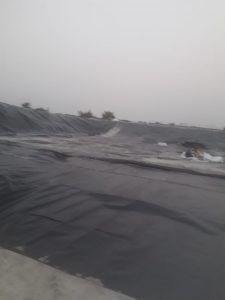Landfill Project at Karnataka – Case Study

Due to the production and release of biogas into the atmosphere, landfills contribute to global warming. Methane gas (CH4) and carbon dioxide (CO2), two gases that contribute to climate change and an increase in global temperatures, are the main components of biogas.
Degassing is frequently done after the landfill cell has been closed, so methane from the more quickly biodegradable components will have already been released into the atmosphere before degassing happens. This is an improvement over typical landfills, but there are still downsides. Better results are obtained from horizontal degassing projects, although they can only catch a percentage of the methane produced while the landfill cell is still in operation.
Bird migration is greatly harmed by landfill sites. Some birds graze near landfills, inadvertently ingesting pollutants like plastic, aluminum, gypsum, and other common waste that can even be harmful, like those found there.
Furthermore, landfills endanger birds by disrupting their migratory patterns, which is another risk. As a result of the limitless food supply landfills offer, an increasing number of species have stopped migrating to the south in recent years and are instead choosing to nest there. This is harmful because, as we have seen, they can die from eating this, and because their young already have a propensity to disregard typical migratory behavior, which makes the situation worse with each passing generation.
Product – Ocean HDPE Liner-1500micron
Quantity – 6000sqm
Location – Karnataka
Problem
Landfills can have a negative impact on water resources. Even though landfilling is currently the most widely utilized waste disposal technique due to its low prices and great availability of marginal land. On water resources, landfilling has a variety of implications.
Liquid waste disposal is a widespread practice in landfills in arid regions. The majority of arid areas experience severe rainfall erosion, which raises the likelihood of contaminated surface and groundwater. Economic and cultural advancements have raised the level of life and altered consumer behavior in the area, which has led to an obvious rise in garbage production.
It is impossible to adequately regulate the foul odours that come from landfills, and they almost always affect the local population. Property values drop in locations close to these garbage storage facilities, thus contributing to the undervaluation of underprivileged communities.
Solution
Nowadays, geosynthetics are frequently used in landfill liner systems. Geotextiles like HDPE and Geosynthetic Liners are frequently utilised. The liner’s job is to keep the water table below and the leachate that is created by the garbage that is being stored apart. A common setup includes an HDPE Liner over a GCL that is in touch with the landfill’s subgrade, followed by a heavy geotextile to give the HDPE mechanical protection. The next step is to add a gravel or sand drainage layer. To act as a filter between the drainage layer and the accumulated waste, a lighter geotextile is frequently placed above the drainage layer.
In order to decrease the amount of primary leachate that needs to be treated and disposed of, geomembranes have also been used to cover landfills in order to stop precipitation penetration as well as to trap and remove landfill gas (LFG). Although HDPE has been used in caps, linear low density polyethylene (LLDPE) or another more flexible polymer, such as PVC or flexible polypropylene (fPP), are often preferred because they may be better able to tolerate the stresses and strains brought on by diverse waste settlements. The geomembrane must therefore have the ability to adapt to the differential settlement profile without putting it under stress that could result in stress cracking. Less crystalline materials like LLDPE and fPP are not susceptible to SC in their as-manufactured state.



